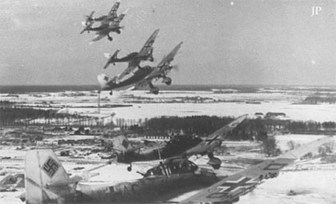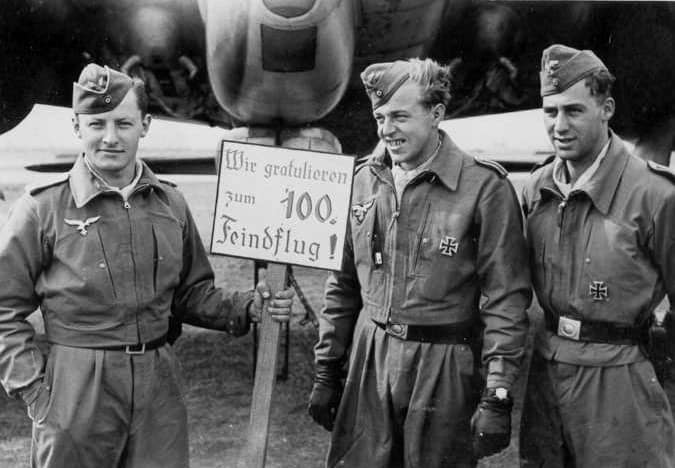The Nazi German Air force 1935-1945 (Luftwaffe)

The Nazi German Air Force, Luftwaffe, was formed in May of 1935. It was formed after the passing of the “Law for the Reconstruction of the National Defense Forces”. This law brought back into existence a free-standing German army, navy, and air force, something that had been essentially banned after the end of World War I.
With the end of World War I and the signing of the Treaty of Versailles in 1919, the Weimar Republic – the successor to Imperial Germany – was allowed only a small defensive military force known as the Reichswehr. The Reichswehr’s size and composition were strictly controlled by the Allies in the hope that by restricting its constitution they could prevent future German military aggression. The Reichswehr consisted of 100,000 men divided between a small standing army, the Reichsheer, and a small defensive navy, the Reichsmarine. There was no provision for an air force of any sort.
Which operation included the German Luftwaffe destroying over 2,000 Soviet aircraft?
Where was the last German Luftwaffe recon mission flown during WW2?
When was the German Luftwaffe officially disbanded?
Which Italian port city was bombed by the German Luftwaffe in 1943?
How many served in the German Luftwaffe during WW2?
Who was the commander of the German Luftwaffe?
Which city in Poland was the first attacked by the German Luftwaffe in 1939?
What percentage of Knight's Cross holders served in the German Luftwaffe?
Try again...read up on your history.
Great Job! You know your history.
In 1933 the National Socialist German Workers Party (NSDAP) came to power and the infamous Third Reich was born. Two years later in 1935, the Treaty of Versailles was renounced and the Reichswehr became the Wehrmacht. The newly formed Wehrmacht would still consist of an army and a navy – the renamed Heer and Kriegsmarine, but a new air force was born as well – the Luftwaffe.
Although officially announced in 1935, the Luftwaffe had existed in one form or another practically since the day the treaty banning it had been signed. Initially, there were Freikorps air units, then later glider and sailplane formations tasked with finding ways around the rigid restrictions of Versailles, a secret training base in the Soviet Union, and various cover organizations for the initial forming of the new German air force.

The Luftwaffe consisted of air units that made up the majority of the German air force, as well as Fallschirmjäger units, field divisions, the elite Herman Göring ground formations, thousands of smaller anti-aircraft, engineer, communications and security units, and a fair number of Luftwaffe naval vessels and formations as well. Between 1939 and 1945 over 3.4 million served in the German air force. Over 165,000 were killed, over 155,000 went missing and over 192,000 were wounded. Of the 7361 men awarded the initial grade of the highest German combat honor of WWII, the Knights Cross, 1785 were from the German air force making up 24% of the total awarded.
Initially, the Luftwaffe ruled the skies but thereafter fought an increasingly futile war of attrition which when combined with vital mistakes in aircraft production and utilization, was its death knell. In the face of this, the Luftwaffe produced the most successful air aces of all time. As well, the feats of the Fallschirmjäger in the first airborne operations in history are as heroic as they are tragic. German paratroops suffered appalling losses during the invasion and Battle of Crete and essentially never saw large-scale airborne operations again. Some ground units fought well during WWII, such as certain field divisions and the elite Hermann Göring formations, while other units simply served.
Ultimately the structure of the Luftwaffe was a grand reflection of its commander, Hermann Göring. He strove more so than any other branch to create a personal army with responsibilities as far-reaching as possible. It was partly due to this that the Wehrmacht was ultimately defeated. The strain on resources and manpower such political maneuvering had was far-reaching.
The Luftwaffe was officially disbanded in August of 1946 by the Allied Control Commission.
The basis for Feldgrau lays within our unit histories. In this section, you will find all units documented to one degree or another. The many gaps in these listings will be filled during the coming months and years as additional research aids completing this monumental reference tool.
WW2 German Luftwaffe Missions Map
Unit histories
- 1935-1945, Luftwaffe Air Units Order of Battle
- 1935-1945, Luftwaffe Ground Units Order of Battle
Specific unit history sections
- Fallschirmjäger-Divisions
- Luftwaffe-Field-Divisions
- German fighter wing units
- German Coastal Defence Groups
- Luftwaffe Infantry Units
Other sources for unit history information
Luftwaffe Aircraft
- Arado Ar 68
- Arado Ar 96
- Arado Ar 196
- Arado Ar 232
- Arado Ar 234
- Arado Ar 240
- Blohm und Voss BV 138
- Blohm und Voss BV 222
- DFS 230
- Dornier Do 17
- Dornier Do 18
- Dornier Do 24
- Dornier Do 215
- Dornier Do 217
- Dornier Do 335
- Fieseler Fi 156
- Focke-Wulf Fw 189
- Focke-Wulf Fw 190
- Focke-Wulf Fw 200
- Focke-Wulf Ta 152
- Focke-Wulf Ta 154
- Gotha Go 242
- Gotha Go 244
- Heinkel He 45
- Heinkel He 46
- Heinkel He 59
- Heinkel He 60
- Heinkel He 111
- Heinkel He 114
- Heinkel He 115
- Heinkel He 162
- Heinkel He 177
- Heinkel He 219
- Henschel Hs 123
- Henschel Hs 126
- Henschel Hs 129
- Junkers Ju 52
- Junkers Ju 86
- Junkers Ju 87
- Junkers Ju 88
- Junkers Ju 90
- Junkers Ju 188
- Junkers Ju 252
- Junkers Ju 290
- Junkers Ju 388
- Messerschmitt Bf 108
- Messerschmitt Bf 109
- Messerschmitt Bf 110
- Messerschmitt Me 163
- Messerschmitt Me 210
- Messerschmitt Me 262
- Messerschmitt Me 321
- Messerschmitt Me 323
- Messerschmitt Me 410
- Siebel Si 204
Before embarking on any study of German unit histories it’s helpful to have access to research material regarding ranks, formations, terms and other related concepts.
- Glossary of German Military Terms
- WW2 Germany Statistics, Numbers, and Losses
- WW2 German Indentification Documents and Tags
- Weapons and equipment
If you have a question about a concept or something specific, you can post a message in our German Armed Forces Forum.
RESEARCH THEMES
OUR RESEARCH THEMES
Select ThemeReichswehrThe German Imperial Army 1918 – 1935
anchourReichsmarineThe German Navy 1919-1935
anchourHeerThe Nazi German Army 1935-1945
anchourLuftwaffeThe Nazi German Air Force 1935-1945
anchourKriegsmarineThe Nazi German Navy 1935-1945
anchourWaffen-SSThe Nazi German Armed Waffen-SS 1933-1945
anchourWehrmachtsgefolgeAuxiliary Organizations
anchourFreiwilligeForeign Volunteers
anchourAlliierteAxis Powers
anchourKollaborationAxis Collaboration
anchour
